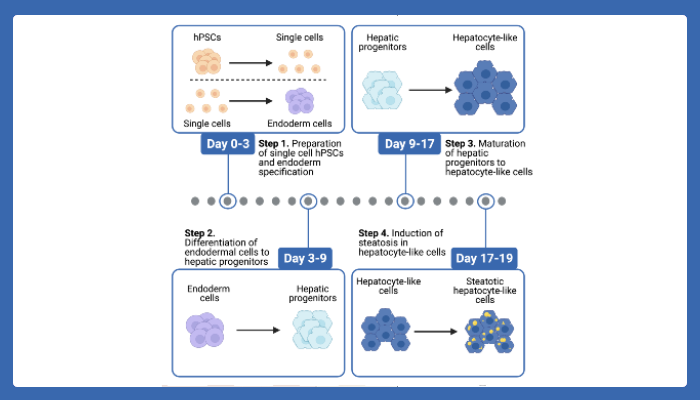NAFLD in a Dish
Published: 28 June 2021
Dr Matthew Sinton has developed a human stem cell-based model of non-alcoholic fatty liver disease (NAFLD) that can be used to study the how the liver can become fatty with the potential for the development of new therapies to treat the disease.

Dr Matthew Sinton has developed a human stem cell-based model of non-alcoholic fatty liver disease (NAFLD) that can be used to study the how the liver can become fatty with the potential for the development of new therapies to treat the disease.
NAFLD is a condition present in the majority of obese and a significant proportion of overweight people in which the liver accumulates fat that can prevent it from working properly.
In some cases, damage caused by the disease becomes permanent, and patients may eventually require liver transplants. In a number of cases, NAFLD can even lead to the development of liver cancer.
NAFLD is challenging to understand because there are so many contributing factors to disease development. As a result, researchers have not yet managed to develop medications that specifically target this condition.
At present, the only way of reversing fat accumulation is through diet and exercise, or gastric bypass surgery.
Working with University of Edinburgh professors Mandy Drake and David Hay during his PhD, Dr Sinton wanted to develop a lab-based tool that could be used to explore NAFLD in greater detail, and in a way that avoids some of the complications of human or animal studies.
By building on the work of others in the lab, they developed a model that was termed 'NAFLD in a Dish', with the paper published in STAR Protocols.
They took human stem cells, which have the capacity to become any other type of cell in the body, and treated them so that they developed into hepatocytes, the cells that make up the bulk of the liver, and then used a combination of fat and sugars to make the cells fatty in a way that resembled human disease.
Using this tool, the team were able to explore how fatty hepatocytes are different from their non-fatty counterparts and gained insight into how fat accumulation impacts on the function of the cell and possibly the whole organ.
Dr Sinton, an iii Immunology Research Assistant, said: "We published the protocol for making this model in STAR Protocols because we hope that this will make the tool accessible to other labs so that they can use it to gain a deeper understanding of NAFLD.
"A major advantage of using this model is that it is easy to study, and it can be scaled up so that, for example, pharmaceutical companies can use it to perform high throughput analysis of different drugs, to see which ones may be suitable for treating the disease.
"The next step is to start developing 3D models of 'NAFLD in a Dish', including organoids, which will provide even deeper insight into the disease and potentially point the way to new classes of treatment."
Modeling human hepatic steatosis in pluripotent stem cell-derived hepatocytes
- Matthew C. Sinton, Jose Meseguer-Ripolles, Baltasar Lucendo-Villarin, Amanda J.Drake, David C.Hay
- STAR Protocols, Volume 2, Issue 2, 2021, 100493, ISSN 2666-1667. https://doi.org/10.1016/j.xpro.2021.100493.
First published: 28 June 2021

